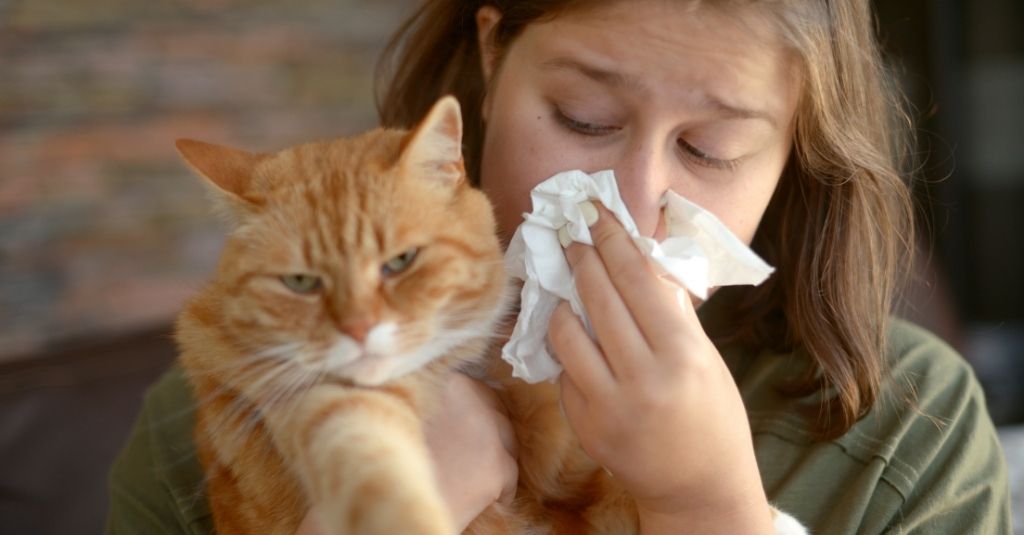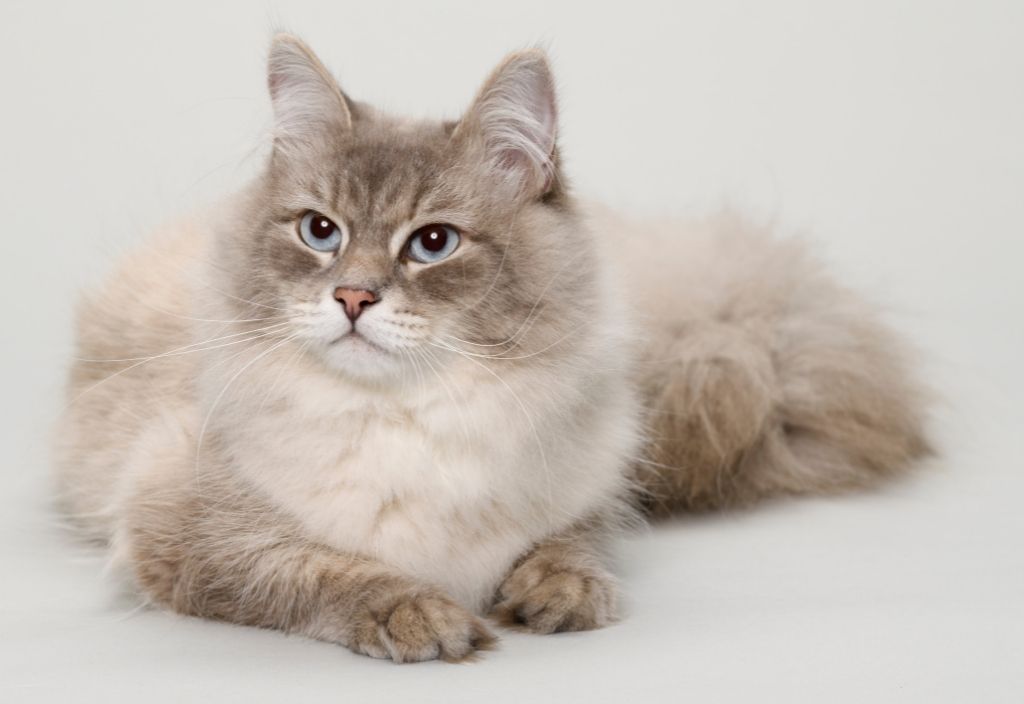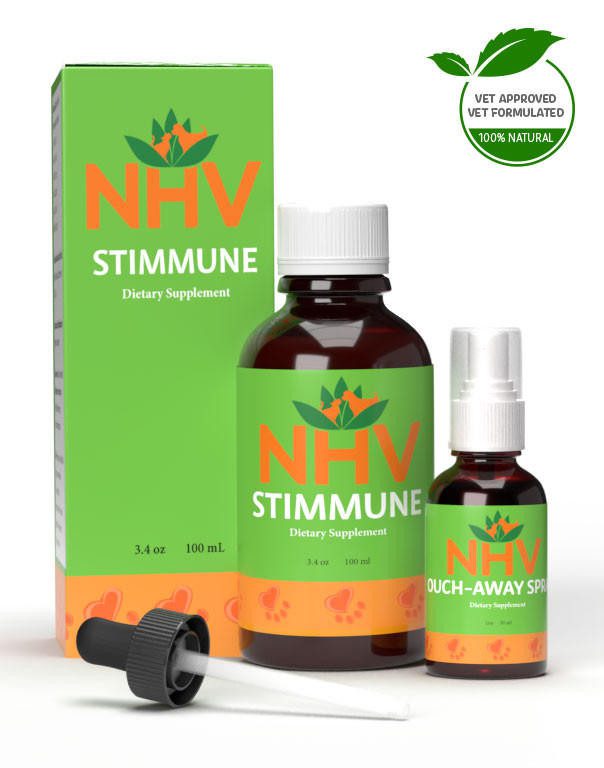multivitamin support

free shipping over $100 (USA & Canada)
1-877-937-4372 the pet expert hotline


You may be one of those unlucky people that is super allergic to cats but has always wanted one! But wait, what about hypoallergenic cats? You may be wondering what the hype is and if there is any truth to this claim! Keep reading to find out more!
Technically, there is no such thing as a hypoallergenic cat.
A sensitivity to pets is the second most common allergy, after pollen and mites. Technically, there is no such thing as a hypoallergenic cat, according to Dr. Lyons, a research veterinarian who runs a genetics lab specifically addressing these kinds of questions about our feline friends. People are not allergic to the hair says Dr. Lyons; “they are allergic to proteins in a cat’s saliva”. And every cat has saliva, lots of it! Many people believe that the amount of fur their kitty has is causing the allergy. This isn’t the case because even hairless kitties are not hypoallergenic!
Yes, if you’re prepared for months, and possibly years of being itchy, sneezy, and puffy. Some allergy sufferers notice that when they adopt a kitty, their allergies decrease, but this may not be the case for everyone. Domestic kitties are unique in the animal kingdom. They produce proteins that no other animal produces (not even dogs). This is why some people are highly allergic to cats and no other species. There are over 8 different proteins in cat saliva that may trigger an allergic response. The Fel d 1 protein is the worst offender. This protein is found in a cat’s skin, saliva, and pee.
Some people believe that the amount of hair a cat has determines how allergic they will be to them. However, kitties with more fur aren’t producing more allergens, they’re just putting more allergens into the environment. This could explain why some people still have allergy symptoms from a cat who may have come for a short visit but is long gone. When a cat licks themself during a regular tongue bath, the saliva containing the Fel d 1 protein dries and becomes an airborne allergen. The hair is a vehicle for the allergen to get into the air. If you’ve ever seen a cat explore their environment – they are sure to cover every square inch of your house in hair!
As mentioned above, an allergenic breed does not exist. But the closest one would have to be a Siberian cat. Certain members of this breed produce different levels of the Fel d 1 protein. A 2017 study suggests that certain gene mutations are responsible for why Siberians may cause a less severe allergic reaction than other breeds. But more research still needs to be done.

Are Sphynx cats hypoallergenic?
Hairless kitties still contain the Fel d 1 protein in their skin, saliva, and urine but because they have little or no hair, there may be less of the allergen in the environment. If you have cat allergies and are considering adopting a kitty, the Sphynx, Peterbald, and other hairless cat breeds may be a good option. Keep in mind that hairless kitties need weekly baths to avoid clogged pores. They are also prone to skin allergies.
Are Rex cats hypoallergenic?
Like hairless kitties, Devon Rexes and Cornish Rexes still produce the Fel d 1 protein but because they only grow an undercoat with little or no topcoat, they tend to shed less than their full-coated cousins so they may release fewer airborne allergens into your home. If you suffer from cat allergies, and you want a feline companion, these kitties may be a good option to consider.
No one knows what the Fel d 1 protein does for our feline friends. Some cats have a little and some have a lot, so we don’t fully understand what the function is. There is no bearing on the breed either. Ragdolls, Bengals, Siamese, Balinese, Maine Coons, Persians, Domestic Short Hairs, Scottish Folds, and Russian Blues all produce the Fel d 1 protein plus all the other proteins that trigger an allergic response. On average, unneutered males produce the most while females produce the least, suggesting that the protein may carry hormones or pheromones. Scientists speculate that it may have a protective effect on the skin but more research needs to be done.
When people say they are allergic to pet dander, what they’re referring to are the proteins in a cat’s saliva! Scientists are currently working on new treatments to improve someone’s immune response to these proteins but they tend to be very costly, require weekly injections, and may not be a permanent solution. For now, if you are a cat allergy sufferer and want a furry friend, you may need to just load up on allergy medication and hope for the best!
For any other burning questions, tap the button below to start chatting with one of our Pet Experts today!
multivitamin support

Herbal Digestive Aid, Energy Booster, and Multivitamin for Cats
buy 2 and save $3
3 month supply for a small to medium size pet
These multivitamins for cats will ensure your kitty (of any age) is getting an extra dose of minerals and vitamins for extra energy, vitality, and health.


These multivitamins for cats will ensure your kitty (of any age) is getting an extra dose of minerals and vitamins for extra energy, vitality, and health.

The health benefits of multivitamins aren’t just for humans. Cats have many of the same nutrient needs as we do, and some need even more than others depending on their age and health.
A multivitamin supplies the vital nutrients your kitty needs to be healthy and to fight off potential health problems. Dr. Cook, DVM, CVA in her blog states that vitamins “help to regulate the body processes, protect the body from environmental toxins, and break down nutrients such as carbohydrates, proteins, and fats so the body can utilize them”.
The best way to give your cat vitamins and minerals are from whole food sources and not just isolated synthetic vitamins. NHV Multi Essentials contains a powerful blend of alfalfa, oat, dandelion, kelp, parsley, marshmallow, chickweed, stinging nettle, Asian ginseng, yucca and Oregon grape.
Health Benefits of NHV’s Multi-Essentials for Cats
With NHV’s multi vitamins for cats, you get a proprietary blend of all-natural ingredients that are organically grown and contain no artificial additives, preservatives, or coloring. Some of the health benefits include:
Multivitamins for cats will ensure your kitty is getting the proper nutrients that could be lacking due to daily stressors, a poor diet, and environmental toxins.
Signs of Vitamin Deficiency in Your Cat
Kitties Who’ve Benefited from NHV Multi Essentials
NHV multi vitamin for cats has helped thousands of pets around the world. Here are just a few of their stories:
DEALING WITH DIGESTIVE ISSUES: MICI THE CAT LOVES HIS VITAMINS NHV MULTI ESSENTIALS
HERBAL MULTIVITAMINS AND TURMERIC HELP CATS, OATMEAL AND MELISSA LIVE HAPPIER
CAN CATS WITH FELV LIVE A HEALTHY AND NORMAL LIFE?
If you have questions regarding holistic support including vitamin supplements for cats, ask an NHV expert because, at NHV, we want your cat to feel clawtastic naturally!
Select your pet's weight to determine the correct dose.
To be taken twice daily. Determine your pet’s weight and then use the easy chart below to determine the correct dose. This is the minimum dosage.
Pet's Weight Dosage
0 - 15 lb = 0.5 ml
16 - 30 lb = 1.0 ml
31 - 45 lb = 1.5 ml
46 - 60 lb = 2.0 ml
61 - 75 lb = 2.5 ml
Over 75 lb = 3.0 ml
How to Administer
Shake well before use. The easiest method is to use the dropper provide and places the drops into your pet’s food or favorite treat. You can also use the dropper and squirt directly into the pet’s mouth.
Some pets can be finicky, if this occurs consider hiding the drops in foods most pet’s love such as fish, chicken or yogurt or a favorite treat. If your pet only eats dry food then soak a few kibbles at feeding time.
For Best Results
Herbal dietary supplements are beneficial to the health and wellbeing of your pet and are safe for long-term use. Every pet responds to natural herbal supplements differently, therefore it is important to be consistent and administer the product daily. Supplements generally take two to four weeks to take effect, however this will vary from one animal to the next.
Product Storage
All NHV Natural Pet Products are pure herbal extracts and contain no artificial additives, preservatives or coloring. Shelf life after opening is 6 months and must be refrigerated after opening.
Cautions and Contraindications
Do not use Multi Essentials in pregnant or nursing animals. Speak to your vet before using our products. A second visit is recommended if your pet’s condition does not improve, or deteriorates after continued use of the supplements.
All information provided by NHV Natural Pet Products is for educational purposes only.
The health benefits of multivitamins aren’t just for humans. Cats have many of the same nutrient needs as we do, and some need even more than others depending on their age and health.
A multivitamin supplies the vital nutrients your kitty needs to be healthy and to fight off potential health problems. Dr. Cook, DVM, CVA in her blog states that vitamins “help to regulate the body processes, protect the body from environmental toxins, and break down nutrients such as carbohydrates, proteins, and fats so the body can utilize them”.
The best way to give your cat vitamins and minerals are from whole food sources and not just isolated synthetic vitamins. NHV Multi Essentials contains a powerful blend of alfalfa, oat, dandelion, kelp, parsley, marshmallow, chickweed, stinging nettle, Asian ginseng, yucca and Oregon grape.
Health Benefits of NHV’s Multi-Essentials for Cats
With NHV’s multi vitamins for cats, you get a proprietary blend of all-natural ingredients that are organically grown and contain no artificial additives, preservatives, or coloring. Some of the health benefits include:
Multivitamins for cats will ensure your kitty is getting the proper nutrients that could be lacking due to daily stressors, a poor diet, and environmental toxins.
Signs of Vitamin Deficiency in Your Cat
Kitties Who’ve Benefited from NHV Multi Essentials
NHV multi vitamin for cats has helped thousands of pets around the world. Here are just a few of their stories:
DEALING WITH DIGESTIVE ISSUES: MICI THE CAT LOVES HIS VITAMINS NHV MULTI ESSENTIALS
HERBAL MULTIVITAMINS AND TURMERIC HELP CATS, OATMEAL AND MELISSA LIVE HAPPIER
CAN CATS WITH FELV LIVE A HEALTHY AND NORMAL LIFE?
If you have questions regarding holistic support including vitamin supplements for cats, ask an NHV expert because, at NHV, we want your cat to feel clawtastic naturally!
Select your pet's weight to determine the correct dose.
To be taken twice daily. Determine your pet’s weight and then use the easy chart below to determine the correct dose. This is the minimum dosage.
Pet's Weight Dosage
0 - 15 lb = 0.5 ml
16 - 30 lb = 1.0 ml
31 - 45 lb = 1.5 ml
46 - 60 lb = 2.0 ml
61 - 75 lb = 2.5 ml
Over 75 lb = 3.0 ml
How to Administer
Shake well before use. The easiest method is to use the dropper provide and places the drops into your pet’s food or favorite treat. You can also use the dropper and squirt directly into the pet’s mouth.
Some pets can be finicky, if this occurs consider hiding the drops in foods most pet’s love such as fish, chicken or yogurt or a favorite treat. If your pet only eats dry food then soak a few kibbles at feeding time.
For Best Results
Herbal dietary supplements are beneficial to the health and wellbeing of your pet and are safe for long-term use. Every pet responds to natural herbal supplements differently, therefore it is important to be consistent and administer the product daily. Supplements generally take two to four weeks to take effect, however this will vary from one animal to the next.
Product Storage
All NHV Natural Pet Products are pure herbal extracts and contain no artificial additives, preservatives or coloring. Shelf life after opening is 6 months and must be refrigerated after opening.
Cautions and Contraindications
Do not use Multi Essentials in pregnant or nursing animals. Speak to your vet before using our products. A second visit is recommended if your pet’s condition does not improve, or deteriorates after continued use of the supplements.
All information provided by NHV Natural Pet Products is for educational purposes only.
overall vitality

For Overall Health and Well-Being
buy 2 and save $3
An Omega 3 supplement for cats to support their joints, heart, eyes, immune system, and overall organ function.


An Omega 3 supplement for cats to support their joints, heart, eyes, immune system, and overall organ function.

Our cat omega 3 supplement is naturally made from the oils of sardines, anchovies, and North Atlantic cod. It’s an excellent source of EPA (Eicosapentaenoic Acid 600mg) and DHA (Docosahexaenoic acid 460mg) essential omega 3 fatty acids. It’s molecularly distilled and cold-pressed to improve the bioavailability
Support your cat with human-grade quality omega 3 fish oil supplements. Many processed pet foods are deficient in this important nutrient. And according to the University of Maryland Medical Center, "It is very important to maintain a balance between omega-3 and omega-6 fatty acids in the diet. A proper balance helps maintain and even improve health."
It’s important for cats to get essential fatty acids through their diet. This omega 3 supplement for cats will help keep them healthy, and even finicky cats actually like to take it.
Benefits of Cat omega 3 supplements:

Suggested Dosage: To be taken once per day. Add to food based on weight chart.
Therapeutic Dosage: Double the quantity for maximum period of 4 weeks or follow veterinarian advise.
Pet’s Weight Dosage
0-15 lb = ¼ tsp
15-30 lb = ½ tsp
30-60 lb = 1 tsp
60-90 lb = 1 ½ tsp
How to Administer: Shake well before use. The easiest method is to add the dosage to your pets food. Some pets can be finicky, if this occurs consider hiding the appropriate amount in food most pet’s love such as fish, chicken, yogurt, or a favorite treat. If your pet only eats dry food then soak kibbles at feeding time.
For Best Results
Dietary supplements are beneficial to the health and well-being of your pet and are safe for long-term use. Every pet responds to natural supplements differently, therefore it is important to be consistent and administer the product daily. Supplements generally take two to four weeks to take effect, however this will vary from one animal to the next.
Product Storage
All NHV Natural Pet Products contain no artificial additives, preservatives or coloring. Shelf life after opening is 6 months and must be refrigerated after opening.
Cautions and Contraindications
Avoid During Pregnancy.
Our cat omega 3 supplement is naturally made from the oils of sardines, anchovies, and North Atlantic cod. It’s an excellent source of EPA (Eicosapentaenoic Acid 600mg) and DHA (Docosahexaenoic acid 460mg) essential omega 3 fatty acids. It’s molecularly distilled and cold-pressed to improve the bioavailability
Support your cat with human-grade quality omega 3 fish oil supplements. Many processed pet foods are deficient in this important nutrient. And according to the University of Maryland Medical Center, "It is very important to maintain a balance between omega-3 and omega-6 fatty acids in the diet. A proper balance helps maintain and even improve health."
It’s important for cats to get essential fatty acids through their diet. This omega 3 supplement for cats will help keep them healthy, and even finicky cats actually like to take it.
Benefits of Cat omega 3 supplements:

Suggested Dosage: To be taken once per day. Add to food based on weight chart.
Therapeutic Dosage: Double the quantity for maximum period of 4 weeks or follow veterinarian advise.
Pet’s Weight Dosage
0-15 lb = ¼ tsp
15-30 lb = ½ tsp
30-60 lb = 1 tsp
60-90 lb = 1 ½ tsp
How to Administer: Shake well before use. The easiest method is to add the dosage to your pets food. Some pets can be finicky, if this occurs consider hiding the appropriate amount in food most pet’s love such as fish, chicken, yogurt, or a favorite treat. If your pet only eats dry food then soak kibbles at feeding time.
For Best Results
Dietary supplements are beneficial to the health and well-being of your pet and are safe for long-term use. Every pet responds to natural supplements differently, therefore it is important to be consistent and administer the product daily. Supplements generally take two to four weeks to take effect, however this will vary from one animal to the next.
Product Storage
All NHV Natural Pet Products contain no artificial additives, preservatives or coloring. Shelf life after opening is 6 months and must be refrigerated after opening.
Cautions and Contraindications
Avoid During Pregnancy.
skin & coat support

Stimmune & Ouch Away Spray
bundle and save with pet expert kits
3 month supply for a small to medium size
Your furkiddo’s skin is at the mercy of biting insects, allergies, fungal overgrowth, and more. They may start to suffer from itchy, inflamed skin and possible fur loss! Help support healthy skin and coat care with NHV’s Skin Relief and Coat Health Kit.

Your furkiddo’s skin is at the mercy of biting insects, allergies, fungal overgrowth, and more. They may start to suffer from itchy, inflamed skin and possible fur loss! Help support healthy skin and coat care with NHV’s Skin Relief and Coat Health Kit.
Your pet's skin is their first line of defense against irritants, molds, and infection-causing pathogens. Once these allergens cross the skin barrier, the immune system kicks in. Any redness or inflammation showing up on the skin could signify that the immune system is under attack! Stimmune offers immune support to bolster your pet's internal defenses, while Ouch Away helps strengthen the body's skin barrier and promotes healing.
Since your furkiddo's skin is their largest organ, it probably doesn't surprise you that skin issues are pretty typical amongst cats and dogs. These include (but are not limited to) itchy skin, parasitic infections, mange (dog specific), and hot spots that may lead to partial or complete fur loss. Certain breeds of dogs such as Chinese Shar-Peis, Wire Fox Terriers, Golden Retrievers, Dalmatians, Boxers, Boston Terriers, Labrador Retrievers, Lhasa Apsos, Scottish Terriers, Shih Tzus, and West Highland White Terriers may be susceptible to dermatitis and skin infections.
However, any breed or mixed breed (dog or cat) may experience coat and skin issues. The most affected areas are typically their paws, face, ears, front legs, and belly, but scratching all over is also common. Stimmune contains ingredients such as astragalus, Echinacea purpurea, and Oregon grape that help enhance immune function, increase white blood cell count, and may help protect the body from various stresses. And in Ouch Away's formulation, ingredients like rosemary, tea tree oil, and lemongrass oil are effective topically against external parasites, help protect the body against infection, and promote fur regrowth (from obsessive licking or biting).
NHV supplements are formulated by a holistic veterinarian and master herbalist to be gentle, effective remedies that complement a vet-formulated care plan, but they should never replace professional advice from your veterinarian. If you have any questions about your pet’s skin and coat care, get in touch with an NHV Pet Expert.
Made with the finest, organically grown, or ethically harvested herbs. Made specifically for pets, vet-formulated, and vet approved.
Stimmune
Ouch Away
Select your pet's weight to determine the correct dose.
STIMMUNE DOSAGE : To be taken twice daily. Determine your pet’s weight and then use the easy chart below to determine the correct dose. This is the minimum dosage.
Pet's Weight Dosage
0 - 15 lb = 0.5 ml
16 - 30 lb = 1.0 ml
31 - 45 lb = 1.5 ml
46 - 60 lb = 2.0 ml
61 - 75 lb = 2.5 ml
Over 75 lb = 3.0 ml
For small animals (rabbits, ferrets), avians and reptiles use 1 drop for every 2 lb of body weight.
How to Administer
Shake well before use. The easiest method is to use the dropper provided and place the drops into your pet’s food or favorite treat. You can also use the dropper and squirt directly into the pet’s mouth. Some pets can be finicky, if this occurs consider hiding the drops in foods most pet’s love such as fish, chicken or yogurt or a favorite treat. If your pet only eats dry food then soak a few kibbles at feeding time.
For Best Results
Herbal dietary supplements are beneficial to the health and well-being of your pet and are safe for long-term use. Every pet responds to natural herbal supplements differently, therefore it is important to be consistent and administer the product daily. Supplements generally take two to four weeks to take effect, however this will vary from one animal to the next.
Product Storage
All NHV Natural Pet Products are pure herbal extracts and contain no artificial additives, preservatives or coloring. Shelf life after opening is 6 months and must be refrigerated after opening.
Cautions and Contraindications
Do not use in pregnant or nursing animals.
OUCH AWAY SPRAY
How to Administer
Topical Spray: Spray several times a day to affected area until healed. It may some times be necessary to shave or trim your pet’s hair so that the Ouch Away spray reaches the affected area. If necessary, cover the affected area with gauze dressing.
Caution
Do not spray near or into eyes or nose. May initially sting on open cut. A vet examination prior to use of this product is recommended. If your pet’s condition does not improve or deteriorates consult your vet and stop the use of the product.
Information presented by NHV Natural Pet Products is for educational purposes only.
Your pet's skin is their first line of defense against irritants, molds, and infection-causing pathogens. Once these allergens cross the skin barrier, the immune system kicks in. Any redness or inflammation showing up on the skin could signify that the immune system is under attack! Stimmune offers immune support to bolster your pet's internal defenses, while Ouch Away helps strengthen the body's skin barrier and promotes healing.
Since your furkiddo's skin is their largest organ, it probably doesn't surprise you that skin issues are pretty typical amongst cats and dogs. These include (but are not limited to) itchy skin, parasitic infections, mange (dog specific), and hot spots that may lead to partial or complete fur loss. Certain breeds of dogs such as Chinese Shar-Peis, Wire Fox Terriers, Golden Retrievers, Dalmatians, Boxers, Boston Terriers, Labrador Retrievers, Lhasa Apsos, Scottish Terriers, Shih Tzus, and West Highland White Terriers may be susceptible to dermatitis and skin infections.
However, any breed or mixed breed (dog or cat) may experience coat and skin issues. The most affected areas are typically their paws, face, ears, front legs, and belly, but scratching all over is also common. Stimmune contains ingredients such as astragalus, Echinacea purpurea, and Oregon grape that help enhance immune function, increase white blood cell count, and may help protect the body from various stresses. And in Ouch Away's formulation, ingredients like rosemary, tea tree oil, and lemongrass oil are effective topically against external parasites, help protect the body against infection, and promote fur regrowth (from obsessive licking or biting).
NHV supplements are formulated by a holistic veterinarian and master herbalist to be gentle, effective remedies that complement a vet-formulated care plan, but they should never replace professional advice from your veterinarian. If you have any questions about your pet’s skin and coat care, get in touch with an NHV Pet Expert.
Made with the finest, organically grown, or ethically harvested herbs. Made specifically for pets, vet-formulated, and vet approved.
Stimmune
Ouch Away
Select your pet's weight to determine the correct dose.
STIMMUNE DOSAGE : To be taken twice daily. Determine your pet’s weight and then use the easy chart below to determine the correct dose. This is the minimum dosage.
Pet's Weight Dosage
0 - 15 lb = 0.5 ml
16 - 30 lb = 1.0 ml
31 - 45 lb = 1.5 ml
46 - 60 lb = 2.0 ml
61 - 75 lb = 2.5 ml
Over 75 lb = 3.0 ml
For small animals (rabbits, ferrets), avians and reptiles use 1 drop for every 2 lb of body weight.
How to Administer
Shake well before use. The easiest method is to use the dropper provided and place the drops into your pet’s food or favorite treat. You can also use the dropper and squirt directly into the pet’s mouth. Some pets can be finicky, if this occurs consider hiding the drops in foods most pet’s love such as fish, chicken or yogurt or a favorite treat. If your pet only eats dry food then soak a few kibbles at feeding time.
For Best Results
Herbal dietary supplements are beneficial to the health and well-being of your pet and are safe for long-term use. Every pet responds to natural herbal supplements differently, therefore it is important to be consistent and administer the product daily. Supplements generally take two to four weeks to take effect, however this will vary from one animal to the next.
Product Storage
All NHV Natural Pet Products are pure herbal extracts and contain no artificial additives, preservatives or coloring. Shelf life after opening is 6 months and must be refrigerated after opening.
Cautions and Contraindications
Do not use in pregnant or nursing animals.
OUCH AWAY SPRAY
How to Administer
Topical Spray: Spray several times a day to affected area until healed. It may some times be necessary to shave or trim your pet’s hair so that the Ouch Away spray reaches the affected area. If necessary, cover the affected area with gauze dressing.
Caution
Do not spray near or into eyes or nose. May initially sting on open cut. A vet examination prior to use of this product is recommended. If your pet’s condition does not improve or deteriorates consult your vet and stop the use of the product.
Information presented by NHV Natural Pet Products is for educational purposes only.
Published: May 7, 2022